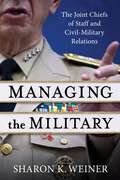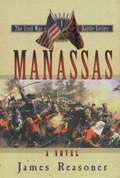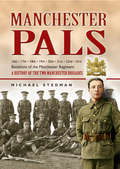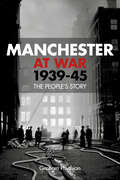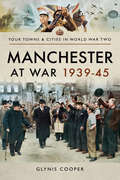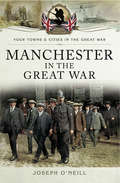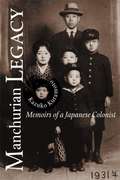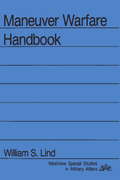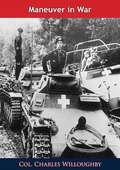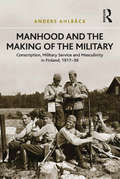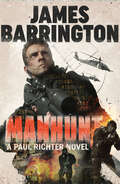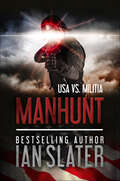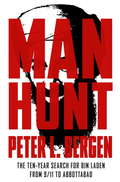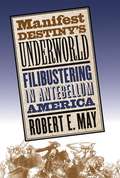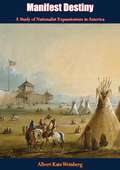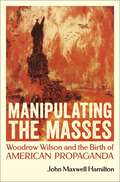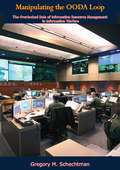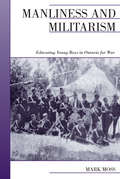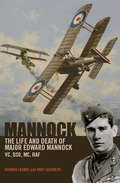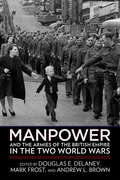- Table View
- List View
Managing the Military: The Joint Chiefs of Staff and Civil-Military Relations
by Sharon K. WeinerThe chairman of the Joint Chiefs of Staff (JCS)—a senior group of officers who lead the Army, Navy, Air Force, and Marine Corps—is perhaps the most influential military figure in the United States. The chairman is the primary military advisor to the president and is often the public face of the armed forces. As advocates for the military’s priorities, some chairmen have used this role to help shape policy, but others have embraced the position as an opportunity to chart new policy directions or challenge presidential preferences.Managing the Military is a pioneering analysis of the power of the chairman of the JCS that sheds new light on civil-military relations in the United States. Using detailed case studies of debates over defense budgets since the end of the Cold War, Sharon K. Weiner examines when and how the JCS chairman opposes civilian defense policy preferences. She shows that, under the right conditions, the chairman can be a policy entrepreneur, challenging the goals of the White House and lobbying for the military’s interests. However, the extent of the chairman’s political clout is constrained by the preferences of the service chiefs who head the branches of the military. Weiner also explores the evolution of the institution of the JCS and illuminates the chairman’s interaction with the president and secretary of defense. Blending empirical detail and theoretical contributions, Managing the Military offers a compelling account of the circumstances under which the power of the JCS chairman is maximized.
Manassas (The Civil War Battle Series, Book #1)
by James Reasoner[FROM THE BACK COVER] THE YANKEE seemed to be unarmed, but he was determined to kill Will with his bare hands. His fingers locked around Will's throat. He had one knee on Will's chest, pinning him to the ground. Will tried to throw the man off, but the Yankee's weight was too much. He was leaning over Will so that his grimacing face was only a foot away from Will's. Suddenly, the Yankee stiffened, and his mouth opened and blood welled out. Will saw the point of a bayonet protruding an inch or so from the center of the man's chest. He fell to the side as his eyes began to glaze over. Darcy Bennet yanked his bayonet out of the Yankee's body and bent over Will to offer him a hand. "Come on, Cap'n," he said, raising his voice to be heard over the chaos. "Are you all right?" Coughing a little as he dragged air through his abused throat, Will nodded. "Thanks, Darcy," he rasped. He looked around for the dun. "Your horse run off," said Darcy. "Don't know where he got off to-" Suddenly, a thudding sound interrupted Darcy, and the big sergeant stumbled back a step. Will looked at him in horror as Darcy slowly lifted a hand and pressed it to his chest. "Lordy," Darcy gasped in a hollow voice. "I'm hit." Then he fell over backward, a dark bloodstain spreading under the widespread fingers of his hand. "Darcy!" Will yelled as he dropped to his knees next to the sergeant. "Damn it, Darcy-" "Brannon!" Will couldn't believe his ears. He turned his head and saw a familiar figure standing ten feet away. Something had happened to Ransom Fogarty's cap during the battle, uncovering his ginger-colored hair. Smoke curled from the barrel of the rifle in his hands. His ugly freckled face split in a grin as he sneered, "I won't miss with this bayonet, Brannon!"
Manchester Pals: A History of the Two Manchester Brigades
by Michael StedmanUnlike its near neighbour, working-class Salford, Manchester proved able to raise eight Pals battalions. Initially, these battalions were composed of middle-class men who experience before the war years was within the commercial, financial and manufacturing interests which formed the foundations of Edwardian Manchesters life and prosperity. Manchester was undeniably proud of its pals battalions; that the area was capable of raising. Seven months after their arrival in France the battle of the Somme was launched, on the fateful 1st July, 1916. On the right of the British Armys extraordinary efforts that day, the Manchester Pals were part of one of the few successful actions, taking the villages of Montauban and Mametz and making a deep incursion into the German defences north of the River Somme.
Manchester at War 1939-45: The People's Story
by Graham PhythianThis new book is a remarkable and moving account of life on the home front in Manchester during the Second World War. Based on transcripts of recorded interviews with senior civilians and former members of the Armed Services, this book provides a first-hand narrative of what it was like to live under the shadow of war. The everyday hardships and heroism are recalled: the Blitz, rationing, the Home Guard, evacuees, war work, and the American presence prior to D-Day. Despite all the tragedy and difficulties, the Mancunian spirit shines through with the frequent dash of unquenchable humour. Richly illustrated, and filled with true accounts of local heroism and of the unbreakable spirit of the people of Manchester during these tumultuous years, this book looks at how the city fared during the Second World War, played her part in victory, and how the day-to-day life of her people was affected.
Manchester at War, 1939–45 (Your Towns And Cities In World War Two Ser.)
by Glynis CooperFew could believe that within twenty years of the war to end all wars being wonthe world was once more at war. Veterans of the Great War feared going throughthe same horrific experience again and, even worse, many knew that this time theirchildren would also be involved in the fighting. What had all the sacrifice been for?Manchester had been badly hit by the Great War with many lives lost, familiesripped apart, industries destroyed. The cotton industry never recovered; especiallysince Japan, China and India offered cheaper cotton goods. Building and economicrecovery had been hindered by the Great Depression.The city was not ready to face another war, nor for the ferocity of the aerial attacksunleashed, nor for the treachery of the Black-Shirts. Yet somehow Manchester foundthe strength to unite against the enemy once more and ensure that Germany wouldnever be victorious.This book chronicles the difficulties, hardships, restrictions and morale of thecity year by year as the war dragged on, and is a timely reminder of how the localcommunity strived to fight the odds that were stacked against them.
Manchester in the Great War (Your Towns & Cities in the Great War)
by Joseph O'NeillHow the experience of war impacted on the town, from the initial enthusiasm for sorting out the German kaiser in time for Christmas 1914, to the gradual realization of the enormity of human sacrifice the families of Manchester were committed to as the war stretched out over the next four years. A record of the growing disillusion of the people, their tragedies and hardships and a determination to see it through. Manchester was more profoundly involved in the Great War than any provincial city. Manchester men volunteered in greater numbers than any others; its women, hardened to the rigours of factory life, flooded into munitions and engineering workshops and toiled long hours while contending with cruel shortages. Children's lives were disrupted as schools became hospitals and the city developed into a major centre for treating the wounded. A great port, an industrial powerhouse, the region's commercial and distribution centre, Manchester overcame hunger and deprivation to become the engine that drove an exhausted and impoverished nation to an unlikely victory.
Manchurian Legacy: Memoirs of a Japanese Colonist
by Kazuko Kuramoto<p>Kazuko Kuramoto was born and raised in Dairen, Manchuria, in 1927, at the peak of Japanese expansionism in Asia. Dairen and the neighboring Port Arthur were important colonial outposts on the Liaotung Peninsula; the train lines established by Russia and taken over by the Japanese, ended there. When Kuramoto's grandfather arrived in Dairen as a member of the Japanese police force shortly after the end of the Russo-Japanese War in 1905, the family's belief in Japanese supremacy and its "divine" mission to "save" Asia from Western imperialists was firmly in place. As a third-generation colonist, the seventeen-year-old Kuramoto readily joined the Red Cross Nurse Corps in 1944 to aid in the war effort and in her country's sacred cause. A year later, her family listened to the emperor's radio broadcast ". . . we shall have to endure the unendurable, to suffer the insufferable." Japan surrendered unconditionally. <p>Manchurian Legacy is the story of the family's life in Dairen, their survival as a forgotten people during the battle to reclaim Manchuria waged by Russia, Nationalist China, and Communist China, and their subsequent repatriation to a devastated Japan. Kuramoto describes a culture based on the unthinking oppression of the colonized by the colonizer. And, because Manchuria was, in essence, a Japanese frontier, her family lived a freer and more luxurious life than they would have in Japan—one relatively unscathed by the war until after the surrender. <p>As a commentator Kuramoto explores her culture both from the inside, subjectively, and from the outside, objectively. Her memoirs describe her coming of age in a colonial society, her family's experiences in war-torn Manchuria, and her "homecoming" to Japan—where she had never been—just as Japan is engaged in its own cultural upheaval.</p>
Maneuver Warfare Handbook
by William S LindManeuver warfare, often controversial and requiring operational and tactical innovation, poses perhaps the most important doctrinal questions currently facing the conventional military forces of the U.S. Its purpose is to defeat the enemy by disrupting the opponent's ability to react, rather than by physical destruction of forces. This book develops and explains the theory of maneuver warfare and offers specific tactical, operational, and organizational recommendations for improving ground combat forces. The authors translate concepts-too often vaguely stated by manuever warfare advocates-into concrete doctrine. Although the book uses the Marine Corps as a model, the concepts, tactics, and doctrine discussed apply to any ground combat force.
Maneuver Warfare Handbook
by William S LindManeuver warfare, often controversial and requiring operational and tactical innovation, poses perhaps the most important doctrinal questions currently facing the conventional military forces of the U. S. Its purpose is to defeat the enemy by disrupting the opponent’s ability to react, rather than by physical destruction of forces. This book develops and explains the theory of maneuver warfare and offers specific tactical, operational, and organizational recommendations for improving ground combat forces. The authors translate concepts--too often vaguely stated by manuever warfare advocates--into concrete doctrine. Although the book uses the Marine Corps as a model, the concepts, tactics, and doctrine discussed apply to any ground combat force.
Maneuver Warfare Handbook
by William S LindManeuver warfare, often controversial and requiring operational and tactical innovation, poses perhaps the most important doctrinal questions currently facing the conventional military forces of the U.S. Its purpose is to defeat the enemy by disrupting the opponent's ability to react, rather than by physical destruction of forces. This book develops and explains the theory of maneuver warfare and offers specific tactical, operational, and organizational recommendations for improving ground combat forces. The authors translate concepts-too often vaguely stated by manuever warfare advocates-into concrete doctrine. Although the book uses the Marine Corps as a model, the concepts, tactics, and doctrine discussed apply to any ground combat force.
Maneuver Warfare Handbook
by William S. LindManeuver warfare, often controversial and requiring operational and tactical innovation, poses perhaps the most important doctrinal questions currently facing the conventional military forces of the U. S. Its purpose is to defeat the enemy by disrupting the opponent's ability to react, rather than by physical destruction of forces. This book develops and explains the theory of maneuver warfare and offers specific tactical, operational, and organizational recommendations for improving ground combat forces. The authors translate concepts-too often vaguely stated by manuever warfare advocates-into concrete doctrine. Although the book uses the Marine Corps as a model, the concepts, tactics, and doctrine discussed apply to any ground combat force.
Maneuver in War
by Col. Charles WilloughbyAn excellent study on the theory of maneuver with many historical illustrations, it is as applicable today as it was when published in 1939.Military movements play critical roles at all three levels of war: tactical, operational, and strategic. This essay explores how the principles of war apply specifically to military movements in the rapidly changing global environment of the late twentieth century. Military movement is critical because it is a means by which ways are made effective to achieve ends. Military movement or the credible potential for movement is essential for the application of each of the principles of war to any conceivable military situation, whether deterrence or combat. Maneuver superiority is essential to the success of future military operations.
Manhood and the Making of the Military: Conscription, Military Service and Masculinity in Finland, 1917–39
by Anders AhlbäckWhen Finland gained its independence from Russia in 1917, the country had not had a military for almost two decades. The ensuing creation of a new national conscript army aroused intense but conflicting emotions among the Finns. This book examines how a modern conscript army, born out of a civil war, had to struggle through social, cultural and political minefields to find popular acceptance. Exploring the ways that images of manhood were used in the controversies, it reveals the conflicts surrounding compulsory military service in a democratic society and the compromises made as the new nation had to develop the will and skill to defend itself. <P><P> Through the lens of masculinity, another picture of conscription emerges, offering new understandings of why military service was resisted and supported, dreaded and celebrated in Finnish society. Intertwined with the story of the making of the military runs the story of how manhood was made and remade through the idealized images and real-life experiences of conscripted soldiers. Placing interwar Finland within a broad European context, the book traces the origins of competing military traditions and ideological visions of modern male citizenship back to their continental origins. It contributes to the need for studies on the impact of the Great War on masculinities and constructions of gender among military cultures in the peacetime period between the two world wars.
Manhunt (An Agent Paul Richter Thriller)
by James BarringtonNobody is above suspicion.In the intelligence world, it hurts when a senior officer goes bad. When that senior officer can’t be identified, it hurts even more. With the security of Britain's most secret files at stake, and trust a commodity in short supply, a deception operation must flush out the traitor.Paul Richter, an unemployed ex-Naval aviator, is the unwitting and ultimately expendable bait in the trap. But as the net closes, a Russian intelligence officer flees Moscow and her evidence points the finger of suspicion in a very different direction…With time running out, and nobody to trust, Richter finds himself battling both the British security establishment and teams of Russian assassins with orders to kill him.For readers of James Patterson, Will Jordan and Chris Ryan, the Agent Paul Richter series is intense, visceral and totally unmissable.
Manhunt (USA vs. Militia)
by Ian SlaterIn the civil war that has gripped America, there are no more neighbors, only side against side, in an increasingly vicious battle for what is left of the country. From bestselling author Ian Slater. "As impelling a storyteller as you're likely to encounter."—Clive Cussler Under an iron fist, the militia movement has mushroomed. Now legendary leaders have been liberated from a heavily guarded Phoenix hospital—and hostages taken for a furious, bloody ride to the California border. It&’s the spark the armies needed and an excuse for the Federals to unleash Patton reincarnate, Gen. Douglas Freeman. In a once peaceful corner, from Sacramento to Seattle, America now burns. A new generation of automated weapons has been brought to the field, the skies split by artillery and the desert nights lit up by infrared. With Americans facing off against Americans, the fight for the USA has reached a turning point. But from the other side of the globe, a new enemy prepares to tip the scales of battle with the ultimate killing tool…
Manhunt: The Ten-year Search for Bin Laden -- from 9/11 to Abbottabad
by Peter L. BergenFrom the author of the New York Times bestselling Holy War, Inc., this is the definitive account of the decade-long manhunt for the world's most wanted man, Osama bin Laden. Al Qaeda expert and CNN national security analyst Peter Bergen paints a multidimensional picture of the hunt for Osama bin Laden over the past decade, including the operation that killed him. Other key elements of the book will include: - A careful account of Obama's decision-making process as the raid was planned - The fascinating story of a group of women CIA analysts who never gave up assembling the tiniest clues about bin Laden's whereabouts - The untold and action-packed history of the Joint Special Operations Command (JSOC) and the SEALs - An analysis of what the death of bin Laden means for Al Qaeda and for Obama's legacy Just as Hugh Trevor-Roper's The Last Days of Hitler was the definitive account of the death of the Nazi dictator, Manhunt is the authoritative, immersive account of the death of the man who organized the largest mass murder in American history.
Manifest Destiny's Underworld
by Robert E. MayThis fascinating study sheds new light on antebellum America's notorious "filibusters--the freebooters and adventurers who organized or participated in armed invasions of nations with whom the United States was formally at peace. Offering the first full-scale analysis of the filibustering movement, Robert May relates the often-tragic stories of illegal expeditions into Cuba, Mexico, Ecuador, Nicaragua, and other Latin American countries and details surprising numbers of aborted plots, as well. May investigates why thousands of men joined filibustering expeditions, how they were financed, and why the U.S. government had little success in curtailing them. Surveying antebellum popular media, he shows how the filibustering phenomenon infiltrated the American psyche in newspapers, theater, music, advertising, and literature. Condemned abroad as pirates, frequently in language strikingly similar to modern American denunciations of foreign terrorists, the filibusters were often celebrated at home as heroes who epitomized the spirit of Manifest Destiny.May concludes by exploring the national consequences of filibustering, arguing that the practice inflicted lasting damage on U.S. relations with foreign countries and contributed to the North-South division over slavery that culminated in the Civil War.Robert May offers an imaginative new approach to antebellum America's notorious "filibusters--the adventurers who organized or participated in private military attacks on nations with which the United States was formally at peace. Condemned abroad as pirates, the filibusters were often celebrated at home as heroes who epitomized the spirit of Manifest Destiny. May explains the romantic, mercenary, ideological, and psychological desires that drove thousands of men to join filibustering expeditions; how they were financed; and why the U.S. government had little success in curtailing them. He also reveals the legacy of anti-Americanism that filibustering generated in Latin America, where people regarded the attackers much the way we look upon international terrorists today.-->
Manifest Destiny: A Study of Nationalist Expansionism in America (History Of The United States Ser.)
by Albert Katz WeinbergA fertile analysis of the ideology of American expansionism and its relation to national action. The history of the moral justifications that have accompanied the development of the United States is an illuminating study of the evolution of American nationalism.“[The author] has painstakingly collected and dissected the arguments employed by American leaders to justify such annexations, beginning with Louisiana and Florida, and ending with the acquisitions growing out of the Spanish War. The object of his quest has been an understanding of the motives which have prompted the territorial growth of the United States.”—New York Times“As a source book in the dicta of democracy it is indispensable.”—New Republic“A clear, dispassionate light on recurring crises in American history. The book should be required reading for imperialists everywhere.”—Christian Science Monitor
Manila And Santiago
by Jim LeekeThe U.S. Navy's first two-ocean war was the Spanish-American War of 1898. A war that was global in scope, with the decisive naval battles of war at Manila Bay and Santiago de Cuba separated by two months and over ten thousand miles. During these battles in this quick, modern war, America s New Steel Navy came of age. While the American commanders sailed to war with a technologically advanced fleet, it was the lessons they had learned from Adm. David Farragut in the Civil War that prepared them for victory over the Spaniards. This history of the U.S. Navy s operations in the war provides some memorable portraits of the colorful officers who decided the outcome of these battles: Shang Dewey in the Philippines and Fighting Bob Evans off southern Cuba; Jack Philip conning the Texas and Constructor Hobson scuttling the Merrimac; Clark of the Oregon pushing his battleship around South America; and Adm. William Sampson and Commodore Scott Schley ending their careers in controversy. These officers sailed into battle with a navy of middle-aged lieutenants and overworked bluejackets, along with green naval militiamen. They were accompanied by numerous onboard correspondents, who documented the war.In addition to descriptions of the men who fought or witnessed the pivotal battles on the American side, the book offers sympathetic portraits of several Spanish officers, the Dons for whom American sailors held little personal enmity. Admirals Patricio Montojo and Pasqual Cervera, doomed to sacrifice their forces for the pride of a dying empire, receive particular attention. The first study of the Spanish-American War to be published in many years, this book takes a journalistic approach to the subject, making the conflict and the people involved relevant to today s readers. This work details a war in which victory was determined as much by leadership as by the technology of the American Steel Navy.
Manipulating the Masses: Woodrow Wilson and the Birth of American Propaganda
by John Maxwell HamiltonWinner of the Goldsmith Book Prize by the Harvard Shorenstein Center on Media, Politics and Public PolicyManipulating the Masses tells the story of the enduring threat to American democracy that arose out of World War I: the establishment of pervasive, systematic propaganda as an instrument of the state. During the Great War, the federal government exercised unprecedented power to shape the views and attitudes of American citizens. Its agent for this was the Committee on Public Information (CPI), established by President Woodrow Wilson one week after the United States entered the war in April 1917.Driven by its fiery chief, George Creel, the CPI reached every crevice of the nation, every day, and extended widely abroad. It established the first national newspaper, made prepackaged news a quotidian aspect of governing, and pioneered the concept of public diplomacy. It spread the Wilson administration’s messages through articles, cartoons, books, and advertisements in newspapers and magazines; through feature films and volunteer Four Minute Men who spoke during intermission; through posters plastered on buildings and along highways; and through pamphlets distributed by the millions. It enlisted the nation’s leading progressive journalists, advertising executives, and artists. It harnessed American universities and their professors to create propaganda and add legitimacy to its mission.Even as Creel insisted that the CPI was a conduit for reliable, fact-based information, the office regularly sanitized news, distorted facts, and played on emotions. Creel extolled transparency but established front organizations. Overseas, the CPI secretly subsidized news organs and bribed journalists. At home, it challenged the loyalty of those who occasionally questioned its tactics. Working closely with federal intelligence agencies eager to sniff out subversives and stifle dissent, the CPI was an accomplice to the Wilson administration’s trampling of civil liberties.Until now, the full story of the CPI has never been told. John Maxwell Hamilton consulted over 150 archival collections in the United States and Europe to write this revealing history, which shows the shortcuts to open, honest debate that even well-meaning propagandists take to bend others to their views. Every element of contemporary government propaganda has antecedents in the CPI. It is the ideal vehicle for understanding the rise of propaganda, its methods of operation, and the threat it poses to democracy.
Manipulating the OODA Loop: The Overlooked Role of Information Resource Management in Information Warfare
by Gregory M. SchechtmanA ground-swell of interest in information as a weapon of warfare is growing within the U.S. armed services. Military strategists are looking at information as a tool to leverage our forces and make them irresistible in battle. Yet, there is little agreement as to what information warfare (IW) is, let alone how it is best fought. This fundamental disagreement is serving as an impediment to unified actions as the Air Force seeks its role in this arena. In particular, information resource management practitioners are questioning their role in supporting this mission. This thesis discusses limitations of existing information warfare interpretations in light of Col John R. Boyd’s decision model, the Observation-Orientation-Decision-Action (OODA) Loop, and offers a synthesized model of information warfare for use in the Air Force. It then offers information resource management (IRM) as a viable decision-support mechanism in that interpretation. By analyzing the applicability of information resource management to the Air Force IW mission, this thesis proposes a better way to view information: a tool for winning the information war through making superior decisions more rapidly than our opponents. An understanding of how IRM and IW relate to one another will provide a model for achieving and maintaining dominance of this new realm of warfare.
Manliness and Militarism
by Mark MossEuphoria swept Canada, and especially Ontario, with the outbreak of World War I. Young men rushed to volunteer for the Canadian Expeditionary Force, and close to 50 per cent of the half-million Canadian volunteers came from the province of Ontario. Why were people excited by the prospect of war? What popular attitudes about war had become ingrained in the society? And how had such values become so deeply rooted in a generation of young men that they would be eager to join this 'great adventure'?Historian Mark Moss seeks to answer these questions in Manliness and Militarism: Educating Young Boys in Ontario for War. By examining the cult of manliness as it developed in Victorian and Edwardian Ontario, Moss reveals a number of factors that made young men eager to prove their mettle on the battlefields of Europe. Popular juvenile literature ? the books of Henty, Haggard, and Kipling, for example, and numerous magazines for boys, such as the Boy's Own Paper and Chums ? glorified the military conquests of the British Empire, the bravery of military men, especially Englishmen, and the values of courage and unquestioning patriotism. Those same values were taught in the schools, on the playing fields, in cadet military drill, in the wilderness and Boy Scout movements, and even through the toys and games of young children.The lessons were taught, and learned, well. As Moss concludes: 'Even after the horrors became known, the conflict ended, and the survivors came home, manliness and militarism remained central elements of English-speaking Ontario's culture. For those too young to have served, the idea of the Great War became steeped in adventure, and many dreamed of another chance to serve. For some, the dream would become a reality.'
Mannock: The Life and Death of Major Edward Mannock VC, DSO, MC, RAF
by Norman Franks Andy SaundersThe definitive biography of the WWI fighter pilot Edward &“Mick&” Mannock—and a revealing investigation into his mysterious fate. Although he was arguably the highest scoring RAF fighter pilot of the First World War, Edward &“Mick&” Mannock&’s life, particularly his death, is still shrouded in mystery. Did he achieve as many victories as are sometimes ascribed to him? How did he die? Where did he die? And more pertinently, where do his remains now lie? Investigative historians Norman Franks and Andy Saunders have assessed all the evidence and cut through the speculation to build a complete picture of the man and his achievements as a fighter pilot. Having unearthed much new and enlightening information, they present a truly balanced overview of his life—and also reveal for the first time exactly where he fell in battle a century ago. Includes photographs
Manpower and Personnel Needs for a Transformed Naval Force
by National Research Council of the National AcademiesThe Department of Defense (DOD) is committed to transforming the nation's armed forces to meet the military challenges of the future. One approach to achieving this transformation is by leveraging advances in science and technology. New technologies and innovations are integral to today's military actions, and associated changes have rippled through all aspects of operations, highlighting the need for changes in policies related to military personnel. At the request of the Force Chief of Naval Operations, the NRC reviewed the military manpower and personnel policies and studies currently underway in the DOD and developed an implementation strategy for the Department of the Navy's future military manpower and personnel needs. This book presents an introduction to current personnel policies of and concerns facing the Naval forces; an assessment of demographic, technological, and other forces affecting future personnel needs and availability; a summary and assessment of previous studies; an examination of the role of research tools in implementing personnel policy change; and an analysis of obstacles to and strategies for transforming the Naval forces.
Manpower and the Armies of the British Empire in the Two World Wars
by Douglas E. Delaney, Mark Frost, and Andrew L. BrownIn the first and only examination of how the British Empire and Commonwealth sustained its soldiers before, during, and after both world wars, a cast of leading military historians explores how the empire mobilized manpower to recruit workers, care for veterans, and transform factory workers and farmers into riflemen. Raising armies is more than counting people, putting them in uniform, and assigning them to formations. It demands efficient measures for recruitment, registration, and assignment. It requires processes for transforming common people into soldiers and then producing officers, staffs, and commanders to lead them. It necessitates balancing the needs of the armed services with industry and agriculture. And, often overlooked but illuminated incisively here, raising armies relies on medical services for mending wounded soldiers and programs and pensions to look after them when demobilized.Manpower and the Armies of the British Empire in the Two World Wars is a transnational look at how the empire did not always get these things right. But through trial, error, analysis, and introspection, it levied the large armies needed to prosecute both wars.Contributors Paul R. Bartrop, Charles Booth, Jean Bou, Daniel Byers, Kent Fedorowich, Jonathan Fennell, Meghan Fitzpatrick, Richard S. Grayson, Ian McGibbon, Jessica Meyer, Emma Newlands, Kaushik Roy, Roger Sarty, Gary Sheffield, Ian van der Waag
